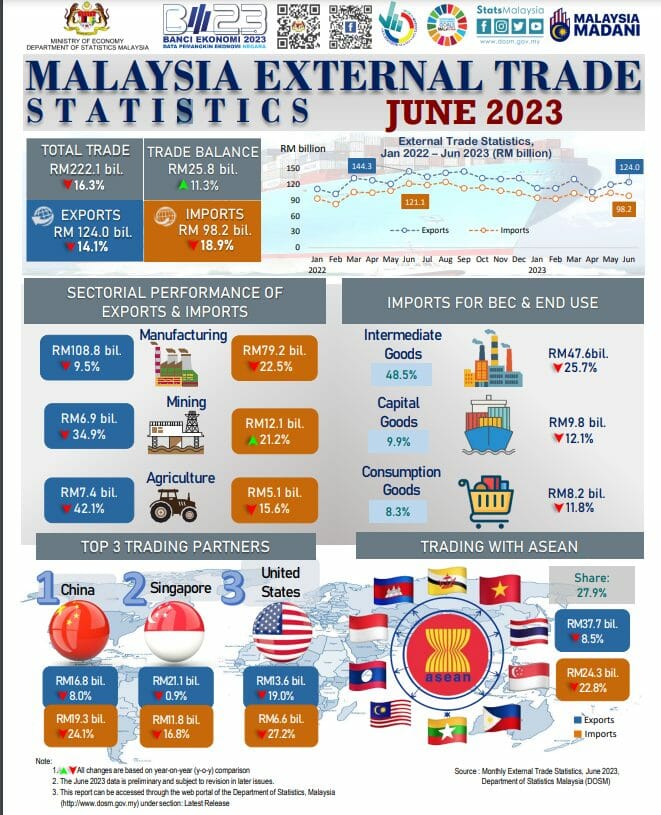DOSM: Volume Of Trade, Trade Surplus Records Contraction Compared To Q2 2022

Malaysia’s total trade recorded a double-digit decline, down 16.3 per cent or RM43.2 billion in June 2023 to post a value of RM222.1 billion as compared to RM265.4 billion in the same month of 2022.
Along with that, the value of exports and imports also experienced a double-digit decrease, flatten by 14.1 per cent and 18.9 per cent respectively, year-on-year(y-o-y). On the other hand, the trade surplus grew by 11.3 per cent or RM2.6 billion to RM25.8 billion.
In comparison to May 2023, exports grew 3.7 per cent or RM4.5 billion, while the trade surplus jumped 64.4 per cent or RM10.1 billion. Meanwhile, imports and total trade recorded a decline, falling 5.4 per cent and 0.5 per cent, respectively.
For the period of the second quarter (Q2) 2023, the volume of trade, exports, imports and trade surplus also recorded a contraction compared to Q2 2022. The volume of trade decreased 11.3 per cent, exports (-11.1%), imports (-11.5%) and trade surplus declined 8.8 per cent.
Chief Statistician Malaysia, Dato’ Sri Dr. Mohd Uzir Mahidin said, “The decline in exports was driven by both domestic exports and re-exports. Domestic exports worth RM93.8 billion, contributing 75.7 per cent to total exports that registered a decrease of 15.2 per cent in June 2023. Re-exports totalled RM30.2 billion, shrank by 10.3 per cent, as compared to June 2022. Imports was lower by 18.9 per cent from RM121.1 billion to RM98.2 billion. Meanwhile, Malaysia’s trade surplus in June 2023 widened to RM25.8 billion as compared to the previous year. This was the 38th consecutive month of trade surplus since May 2020.
“In comparison to May 2023, exports and trade surplus grew by 3.7 per cent and 64.4 per cent, while imports and total trade contracted by 5.4 per cent and 0.5 per cent, respectively.”
In perspective of commodity group, 144 out of 257 groups showed decreases as compared to the same month of the previous year and led by refined petroleum products. As for imports, 174 out of 259 groups recorded negative growth.
Mohd Uzir explained that the reduction in exports was mainly contributed by the United States (-RM3.2 billion), followed by the European Union (-RM2.7 billion), Bangladesh (-RM1.9 billion), Japan (-RM1.8 billion), India (-RM1.7 billion), Thailand (-RM1.6 billion), China (-RM1.5 billion), Taiwan (-RM1.1 billion) and Hong Kong (-RM1.0 billion). Meanwhile, the decrease in imports was mainly attributed from China (-RM6.1 billion), Taiwan (-RM2.7 billon), Republic of Korea (-RM2.6 billion), the United States (-RM2.5 billion), Singapore (-RM2.4 billion), Indonesia (-RM1.9 billion), Australia (-RM1.6 billion), the European Union (-RM1.6 billion) and India (-RM1.1 billion).
Commenting further on exports, the fall was driven by palm oil & palm oil-based agricultural products (-RM5.3 billion); petroleum products (-RM5.1 billion); liquefied natural gas (-RM2.6 billion); crude petroleum (-RM1.4 billion); palm oil-based manufactured products (-RM1.4 billion) and chemical & chemical products (-RM1.3 billion). Meanwhile, the contraction in imports was recorded for electrical & electronic products (-RM7.2 billion); petroleum products (-RM7.1 billion); chemical & chemical products (-RM2.2 billion); manufactures of metal (-RM1.5 billion); transport equipment (-RM1.4 billion); liquefied natural gas (-RM1.1 billion); iron & steel products (-RM1.0 billion).
He said, “The decrease in imports by End Use was contributed by lower demand for intermediate goods, capital goods and consumption goods. Imports of intermediate goods (48.5% of total imports) amounted to RM47.6 billion, posted double digit decrease of 25.7 per cent or RM16.5 billion. Capital goods with a value of RM9.8 billion, shrank by 12.1 per cent as compared to June 2022 and comprised 9.9 per cent of total imports.
“Consumption goods (8.3% of total imports), recorded an 11.8 per cent decrease from RM9.2 billion in the previous year to RM8.2 billion.”
In addition, total trade for the second quarter (Q2) of 2023 declined by 11.3 per cent to RM643.2 billion, compared to Q2 2022. Exports dropped by 11.1 per cent from RM392.3 billion in the preceding year to RM348.7 billion and imports with a value of RM294.5 billion, eased by 11.5 per cent. A trade surplus of RM54.1 billion was recorded for the period, shrank by 8.8 per cent.
During the first six months of 2023, total trade, exports, imports and trade surplus registered a decrease. Total trade decreased by 4.6 per cent, supported by the decline in exports (-4.5%) as well as imports (-4.7%). Consequently, trade surplus recorded a higher value of RM118.5 billion.
Malaysia’s exports in June 2023 contracted by RM20.3 billion or 14.1 per cent to RM124.0 billion compared to June 2022, in line with the decline in domestic exports and re-exports. Domestic exports were valued at RM93.8 billion, contributing 75.7 per cent to total exports fell 15.2 per cent, while re-exports amounting to RM30.2 billion declined by 10.3 per cent.
Meanwhile, on a monthly basis, exports increased by 3.7 per cent or RM4.5 billion. With regards to analysis of the seasonally adjusted terms month-on-month (m-o-m), exports was down 7.7 per cent or RM9.8 billion to RM118.0 billion.

